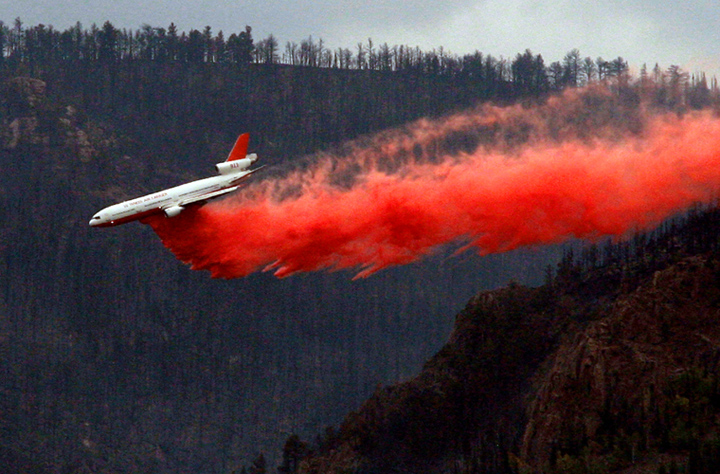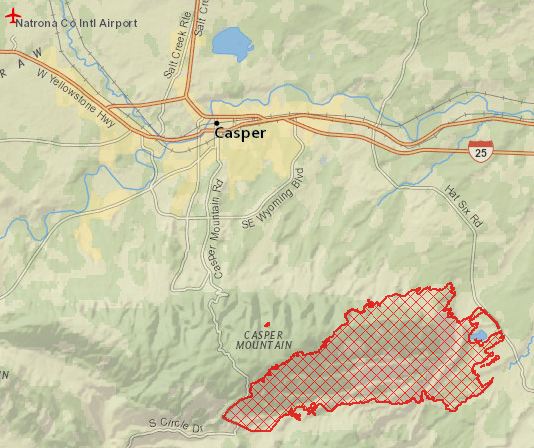
This spectacular photo of Air Tanker 911, a DC-10, dropping on the Sheep Herder Hill Complex near Casper, Wyoming was taken by Alan Rogers of the Casper Star-Tribune yesterday. The photo, along with the video we posted on September 10, tends to disprove the assertions that the Very Large Air Tankers can only be used in “flat or gently-rolling terrain”.
The Casper Star-Tribune has several other photos of the interior of the DC-10 on their web site along with an article about the aircraft. We thank Mr. Rogers for allowing us to use this excellent photograph.
The fire, which became known as the Sheep Herder Hill Complex when a new fire started a couple of miles away Monday night, grew by about 600 acres on Tuesday to a total of 15,887 acres, according to Neal Kephart, a spokesperson for the fire. The Type 2 Incident Management Team led by Incident Commander Todd Pechota took over management of the new fire, named Elkhorn, and aggressively attacked it Monday and Tuesday with engines, aircraft, and smokejumpers, stopping the spread after it burned 8 acres.

Evacuations are still in effect for 150 homes, and another 800 are threatened, according to Mr. Kephart.
Firefighters are getting a break from the weather today, with a forecast for a high temperature of 67 degrees and a 7 to 9 mph wind out of the east and northeast. The relative humidity will bottom out at 21%.
The DC-10 and Tanker 40, a BAe-146, are still parked at the Casper airport 15 miles northeast of the fire along with 4 single engine air tankers, but as of 11:30 a.m. today had not been used yet today.
Other resources on the fire include 7 helicopters (4 large Type 1s, and 3 smaller Type 3s), 17 engines, 4 dozers, and 292 personnel. Two of the helicopters are from the National Guard.


Our country is broke and cannot afford it all anymore. So how many engines, who do the real IA, should get cut so we can have more spectacular pictures to post on the web? Maybe we should have mega crews of 100 so we can concentrate all of our capacity in one place rather than having resources that can be dispatched in more than one direction or to more than one fire at a time. Better yet, let’s get one airtanker that carries a 100,000 gallons. It will be the best and the Forest Service will have to contract for it because it can pump even more wasted retardant, cost more and could claim to have pumped a TRILLION GALLONS!!!!
Louis- airtankers save money in the long run.
Part of the tookbox ace, the reason we have so many fires now is the lack of real IA. Not just crews on the ground, tankers, helicopters,helitack,smokejumpers. etc,etc.
some things work better than others in certain
situations but it all works. All of it.
Dr. Gabbert is correct, poking fun. This is an incrediable photo, as many of the DC-10’s pictures have been over the last five years and a little short of a half a BILLION GALLONS delivered. I’m the “nut” that wrote and was published “Bumbo Jets to Protect the WUI”. (1980). In 1964 T.B.M.’s and P.B.Y’s were the backbone of fire aviation. B-17’s, PB4Y’s where starting to be introduced but with a little “there sort of big?” In a early 60’s publicaion by CDF the most a fire boss can expect from air tankers are drops of 300 to 500 gallons per run. I hope Mr. Alan Rogers of the Casper Tribune understands that this photo is award quality. I’m going to put my fishing pole away, too many upset fish.
I think Johnny was just repeating what the USFS Fire Aviation Management in DC thinks. The VLATS have worked very well and its a shame to see this as their last season. I have no kind words for those in DC that are behind those decisions so I will shut up now. Reality is we need all the VLATS period!
@Johnny, I’ve found this web site to be factual. The fact that you think the DC-10 can’t maneuver the way an S2 can our any smaller tanker, is a misnomer. Of course it can’t! However, that guy retouching those photos must know a lot of different people from all over the country, because there have been hundreds of photos this year of tanker 911 making drops. Why is it so hard to believe? Until you have been on a fire watching it drop, your conspiracy theory on photo manipulation falls flat. You are accusing the photographer of altering an image, which in reality if he did, would get him fired, putting at risk his career and family. My advice to you would be to throw away any mis-conceptions you have about aerial firefighting and read up on 21st century aviation. Thanks.
Either Johnny is kidding or I’m too easily fooled into thinking he’s kidding. “>D
Sarcasm does not translate too well digitally does it? 🙂
Right, Matt. Johnny is not the first person to be taken seriously when he was poking fun.
I think this photo is a phony. I have read the technical data on the B-747 and DC-10 from the Australia fire service and U.S. land managers and according to their expert data gathering there is no way this picture could be authentic.The nut that authored “Jumbo Jets to protect the WUI” (1980) must still be around touching up photos. If you look closely inside one of the windows of the DC-10 you might make out an airline passenger. What’s next, that B-17’s and DC-7’s where used as air tankers? I remember reading somewhat the same reports in the early ’60 that these airplanes where of little value because of their size.
JCW- 🙂
Johnny, I saw the Australian expert data gathering and reports. There were few that actually knew what they were seeing. I was on a team here managing the DC 10 base and saw its maneuverability and I reckon it’s okay.
As for the Evergreen 747 it has never been here.
Just looking at that cavernous interior I spotted a few things that reminded me of the interior of a DC7 obviously
Douglas…. Thanks…
Nice shot of the DC-10! In another proof that the VLAT’s are used in steep terrain came earlier this month when tanke
r 910 dropped on the Goff fire/ Fort complex on the Klamath NF outside of Happy Camp. It was quite a sight to see it diving into and out of our steep canyons!